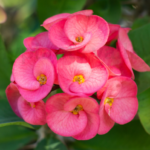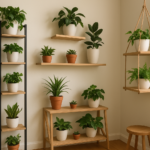Echeveria Lilac Frost is a charming and versatile succulent that has captured the hearts of gardeners and indoor plant enthusiasts around the world. With its silvery, pastel hues and elegant rosette form, this succulent not only enhances the visual appeal of any space but also thrives with minimal care. Whether you’re a seasoned succulent collector or just starting your gardening journey, understanding the nuances of Echeveria Lilac Frost can help you enjoy its beauty for years to come.
Overview of Echeveria Lilac Frost

Echeveria Lilac Frost is renowned for its unique coloration and stunning structure. Characterized by a frosty, pale lavender appearance, this succulent stands out among its peers. Its rosette of fleshy leaves, often tinged with hints of blue and grey, creates an almost ethereal look that many gardeners find irresistible. As a member of the Crassulaceae family, this plant is aesthetically pleasing and remarkably resilient, making it ideal for indoor and outdoor environments.
History and Origin
Native to the arid regions of Mexico, Echeveria Lilac Frost has a storied past rooted in nature’s harshest landscapes. Over centuries, it has adapted to survive extreme conditions, evolving to store water in its thick leaves and flourish in environments where few other plants can. Its popularity surged in recent decades as succulent trends took hold worldwide, driven by its ease of care and its impressive visual appeal in modern home décor.
Characteristics of Echeveria Lilac Frost
Unique Appearance and Color Palette
One of the most striking features of Echeveria Lilac Frost is its color. The leaves often display a frosty, lilac hue, accented by subtle variations of blue and silver. This color variation is not just eye-catching—it also helps the plant reflect sunlight, which can be an adaptive trait in its native, sun-drenched habitats. The soft, velvety texture of the leaves adds another layer of appeal, inviting both tactile exploration and visual admiration.
Size, Growth Habit, and Lifespan
Typically forming compact rosettes, Echeveria Lilac Frost is a slow-growing succulent. Most specimens remain under a foot in diameter, making them perfect for window sills, desktops, or as part of a larger succulent arrangement. While they may appear delicate, these succulents are robust and can thrive for many years with proper care. Over time, they may produce offsets (or “pups”) that can be separated and grown into new plants, further extending the lifespan and charm of your collection.
Ideal Growing Conditions

Light Requirements
Light is one of the most critical factors for the healthy growth of Echeveria Lilac Frost. These succulents thrive in bright, indirect sunlight. While they can tolerate some direct sun, especially during the cooler parts of the day, too much intense, direct sunlight can lead to sunburn. Ideally, positioning them near a window that receives plenty of light without harsh midday rays will allow them to flourish.
Temperature and Climate Considerations
Being native to warm, arid environments, Echeveria Lilac Frost prefers temperatures that are consistently warm. They do well in climates that mimic their natural habitat, typically ranging between 65°F to 80°F (18°C to 27°C) during the day. However, they can tolerate cooler temperatures during the winter months, as long as they are kept dry. Avoid exposure to frost, as this can damage the delicate tissues of the plant.
Soil Composition and Drainage
A well-draining soil mix is essential for preventing water retention and root rot—a common problem with succulents. Use a blend that incorporates coarse sand, perlite, or pumice mixed with regular potting soil to mimic the gritty, well-draining conditions of their native habitat. Repotting every couple of years with fresh soil can rejuvenate your Echeveria and promote healthy root growth.
Watering and Fertilizing Essentials
Proper Watering Techniques
Watering Echeveria Lilac Frost correctly is perhaps the most crucial aspect of its care. These succulents store water in their leaves, which means overwatering can be detrimental. A good rule of thumb is to allow the soil to dry out completely between waterings. During the growing season, watering once every 10 to 14 days is usually sufficient. In winter, when the plant enters dormancy, reduce watering further to prevent any moisture-related issues.
Best Fertilizers for Succulents
While Echeveria Lilac Frost is not a heavy feeder, a diluted, balanced succulent fertilizer can help enhance its growth and coloration. Fertilize during the active growing season, typically in spring and summer, and avoid over-fertilization, which can lead to rapid, weak growth. Organic fertilizers, such as fish emulsion or seaweed extracts, are excellent choices that support sustainable growth.
Planting and Propagation
Planting Tips for Beginners
Planting your Echeveria Lilac Frost in a suitable pot with adequate drainage is key. Start by selecting a container that is slightly larger than the plant’s root ball, and fill it with a well-draining succulent mix. Gently remove the plant from its current container, tease apart any tightly bound roots, and place it in its new home. After planting, allow the soil to settle and avoid watering immediately for a few days to help the plant adjust to its new environment.
Propagation Methods: Offsets and Leaf Cuttings
One of the most satisfying aspects of caring for Echeveria Lilac Frost is watching it produce offsets. These baby plants can be gently separated from the parent plant once they have developed a few leaves of their own. Alternatively, propagation through leaf cuttings is also effective. Carefully remove a healthy leaf, let it dry for several days until a callus forms, and then place it on top of a moist, well-draining medium. With patience, new rosettes will emerge, giving you multiple plants from a single mother plant.
Common Pests and Diseases
Recognizing Common Pests
Despite its resilience, Echeveria Lilac Frost can fall prey to pests such as mealybugs, aphids, and spider mites. These tiny invaders often hide in the crevices of the rosette, feeding on the plant’s sap and causing discoloration or stunted growth. Regular inspection of your succulent, especially during the warmer months, can help catch infestations early.
Prevention and Treatment Options
Preventative care is the best approach when it comes to pests. Ensure that your plant has proper air circulation and is not overcrowded by other plants. If pests do appear, treat your Echeveria with a gentle insecticidal soap or neem oil solution. For severe infestations, a more targeted pesticide may be necessary, but always follow the instructions carefully to avoid damaging the succulent.
Indoor vs Outdoor Cultivation
Growing Indoors: Best Practices
Indoor cultivation of Echeveria Lilac Frost can be immensely rewarding, especially when you create a dedicated succulent display. Place your plant in a bright, sunny window that avoids harsh, direct sunlight during the peak of the day. Consider using artificial grow lights during the darker winter months to ensure your succulent receives enough light. Regularly rotate the pot to ensure even light exposure and prevent the plant from leaning towards the light source.
Outdoor Garden Tips
For those with warmer climates, outdoor cultivation can be equally satisfying. Choose a sheltered spot that receives plenty of sunlight while offering protection from intense afternoon heat. In an outdoor setting, you can combine Echeveria Lilac Frost with other succulents and drought-resistant plants to create a vibrant, low-maintenance garden. Ensure that the planting area has excellent drainage, and be mindful of the microclimate within your garden, which can sometimes differ significantly from the general weather patterns.
Maintenance and Pruning
When and How to Prune
Maintaining your Echeveria Lilac Frost involves minimal pruning. Pruning is typically only necessary when removing dead or damaged leaves or when you need to shape the plant for aesthetic reasons. Use sharp, sterilized scissors or pruning shears to make clean cuts, and always dispose of any removed plant material properly to avoid the spread of disease.
Seasonal Maintenance Guidelines
Seasonal maintenance is another important aspect of caring for your succulent. During the growing season, occasional fertilizing and repotting can help maintain the plant’s vigor. In contrast, during the winter dormancy period, reduce watering and keep the plant in a cooler environment. Regularly dust the leaves with a soft brush or cloth to ensure optimal light absorption and to keep pests at bay.
Landscaping Ideas with Echeveria Lilac Frost
Combining with Other Succulents and Plants
Echeveria Lilac Frost’s striking appearance makes it a perfect centerpiece in any succulent garden. Pair it with other varieties of Echeveria, Sedum, and Aloe to create a diverse and visually stimulating arrangement. Its cool hues complement warmer-colored succulents, providing a balanced, harmonious garden display that draws the eye.
Creative Garden Layouts
There are endless possibilities when it comes to designing a garden that features Echeveria Lilac Frost. Consider creating a rock garden with a mix of gravel, boulders, and native desert plants, or use it as a focal point in a container garden arranged with various textures and heights. Its versatility allows it to blend into modern minimalist landscapes or more eclectic, bohemian-style gardens with equal grace.
Seasonal Care Tips
Winter Care and Protection
In colder months, protecting your Echeveria Lilac Frost becomes essential. While these succulents can tolerate cooler temperatures, exposure to frost can cause irreversible damage. Move potted plants indoors or to a sheltered location, and reduce watering to match the slower growth rate during winter. Covering outdoor specimens with frost cloths during unexpected cold snaps can also offer necessary protection.
Summer and Growing Season Strategies
During the active growing season, focus on providing plenty of light and moderate watering. Although the summer sun is beneficial, it can also be harsh, so consider providing partial shade during the hottest parts of the day. Regularly check the soil moisture and adjust your watering schedule to ensure that the plant is neither overwatered nor left too dry.
Troubleshooting Common Issues
Managing Root Rot and Overwatering
One of the most common challenges faced by succulent enthusiasts is root rot, often caused by overwatering or poorly draining soil. If you notice that your Echeveria Lilac Frost’s leaves are becoming mushy or discolored, it may be time to reassess your watering habits. Repotting the plant in fresh, well-draining soil and removing any affected roots can help restore its health.
Addressing Underwatering and Sunburn
While overwatering poses a risk, underwatering can also stress your succulent, causing the leaves to wrinkle or lose their vibrant color. In addition, sudden exposure to intense sunlight after a period of low light can result in sunburn, leaving behind bleached patches. Balancing light and water is key—ensure that your plant receives steady, moderate care throughout the year.
Benefits of Growing Echeveria Lilac Frost
Aesthetic Appeal and Versatility
One of the most rewarding aspects of growing Echeveria Lilac Frost is its undeniable aesthetic appeal. Its unique coloration and symmetrical rosette form add an element of sophistication to any space. Whether arranged in a decorative pot indoors or integrated into a larger outdoor garden, this succulent acts as both a living work of art and a conversation piece.
Low-Maintenance and Eco-Friendly Advantages
Beyond its beauty, Echeveria Lilac Frost is incredibly low-maintenance. Its natural adaptations to arid climates mean it requires minimal water and care, making it perfect for busy gardeners or those new to succulent care. Additionally, by choosing a plant that thrives on minimal resources, you’re contributing to a more sustainable and eco-friendly gardening practice.
Expert Tips and Insider Secrets
For those looking to take their succulent care to the next level, here are some expert tips:
- Rotate Regularly: To ensure even growth and light distribution, rotate your plant periodically.
- Avoid Cold Drafts: Sudden temperature changes can shock your succulent, so keep it away from air conditioners or drafty windows during the cold months.
- Monitor Soil Moisture: Use a moisture meter or simply test the soil with your finger before watering to avoid overwatering.
- Experiment with Containers: Echeveria Lilac Frost looks fantastic in unique pots or hanging planters that allow for creative garden displays.
- Learn from Failures: Even experienced gardeners encounter issues—use each setback as a learning opportunity to refine your care routine.
Conclusion
Echeveria Lilac Frost is more than just a succulent—it’s a testament to nature’s ingenuity and beauty. From its frost-like hues and resilient nature to its ability to thrive in a range of conditions, this plant offers both aesthetic pleasure and practical benefits. Whether you’re curating a sophisticated indoor collection or designing an outdoor succulent garden, understanding the intricacies of caring for Echeveria Lilac Frost can make all the difference. Embrace the journey of nurturing this captivating plant, and you’ll not only witness its natural charm but also enjoy the rewarding experience of cultivating a thriving green oasis.
FAQs
Q1: How often should I water my Echeveria Lilac Frost?
A1: Water your succulent only when the soil is completely dry—generally every 10 to 14 days during the growing season and less frequently during winter.
Q2: Can I grow Echeveria Lilac Frost indoors?
A2: Yes, they thrive indoors as long as they receive ample indirect sunlight and are placed in well-draining soil.
Q3: What is the best way to propagate Echeveria Lilac Frost?
A3: Propagation can be done using offsets or leaf cuttings. Allow the removed leaves to callus before placing them on moist soil for new growth.
Q4: How can I prevent pests on my Echeveria Lilac Frost?
A4: Regularly inspect your plant for common pests like mealybugs and spider mites. Ensure good air circulation and use insecticidal soap or neem oil for treatment if needed.
Q5: What should I do if my Echeveria shows signs of root rot?
A5: If root rot is suspected, remove the plant from its pot, trim away any rotten roots, and repot in fresh, well-draining soil while adjusting your watering habits.







